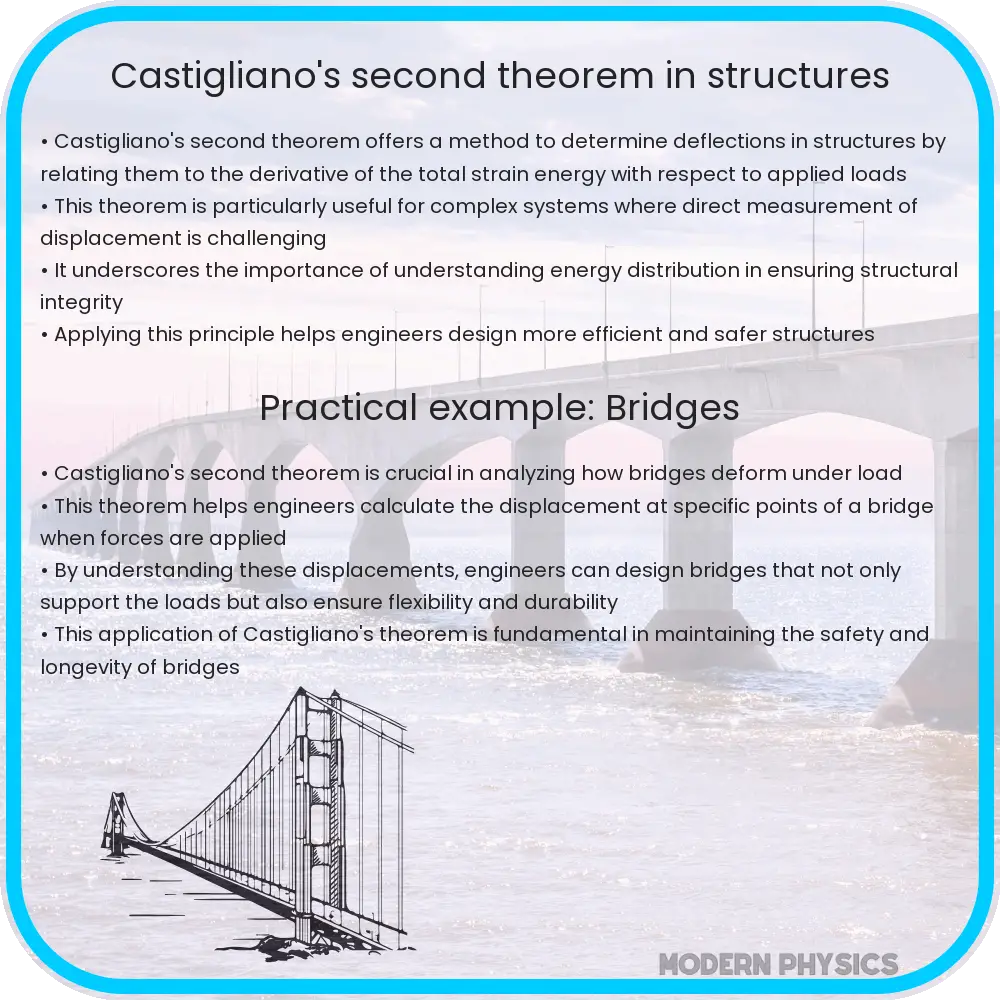Explore Castigliano’s Theorem in statics: its history, applications in structural engineering, integration with modern tools, and practical limitations.

Understanding Castigliano’s Theorem in Statics
Castigliano’s theorem, a fundamental principle in the field of structural engineering and statics, offers a streamlined approach to analyzing and designing structures. It simplifies the complex calculations involved in determining the displacements and deformations of structures under various loads. This theorem is particularly valuable in the design and analysis of beams, trusses, and frames, where it aids in predicting structural behavior with precision.
Historical Background and Development
Developed in the 19th century by Italian engineer Alberto Castigliano, this theorem revolutionized the way engineers approached structural analysis. Castigliano’s work focused on the energy methods in structural analysis, introducing a novel approach that considered the strain energy of a structure. His theories laid the groundwork for modern computational methods used in structural engineering.
The Essence of Castigliano’s Theorem
At its core, Castigliano’s theorem states that the partial derivative of the total strain energy in a structure due to elastic deformation, with respect to a specific load, gives the displacement in the direction of that load. Mathematically, it can be expressed as:
\[ \delta = \frac{\partial U}{\partial P} \]
where \(\delta\) represents the displacement in the direction of the load \(P\), and \(U\) is the total strain energy of the structure.
Applications in Structural Analysis
Castigliano’s theorem is extensively used in the analysis of statically indeterminate structures. These are structures with more unknowns than equilibrium equations available, making traditional methods insufficient for analysis. The theorem simplifies this by converting the problem into an energy-based approach, where the focus is on minimizing the strain energy.
Advantages of Using Castigliano’s Theorem
- Simplicity in Complex Calculations: It reduces the complexity of calculations in statically indeterminate problems, making them more manageable.
- Precision in Structural Behavior Prediction: The theorem offers a high degree of accuracy in predicting deformations and displacements in structures.
- Versatility: It is applicable to a wide range of structural elements, including beams, trusses, and frames.
Conclusion
The significance of Castigliano’s theorem in structural engineering cannot be overstated. It provides an efficient and accurate method for analyzing and designing structures, which is essential in ensuring their safety and functionality. As we delve further into the specifics of this theorem, we will explore its application in real-world scenarios, and how it continues to influence modern structural engineering practices.
Real-World Applications and Examples
Castigliano’s theorem finds practical application in numerous engineering scenarios. For example, in bridge design, it helps in calculating deflections and rotations at critical points, ensuring the bridge can withstand various loads. Similarly, in building frameworks, it assists in determining the response of structural components to different stress conditions, contributing to safer and more efficient designs.
Integrating Castigliano’s Theorem with Modern Computational Tools
In the era of advanced computational tools and software, Castigliano’s theorem has adapted well. It is often integrated into finite element analysis (FEA) programs, providing a theoretical basis for these sophisticated tools. This integration has enhanced the precision and efficiency of structural analysis, allowing engineers to model complex structures and predict their behavior under various loading conditions with remarkable accuracy.
Challenges and Limitations
While Castigliano’s theorem is a powerful tool, it has its limitations. It is primarily applicable to elastic deformations and may not provide accurate results for materials exhibiting plastic behavior. Furthermore, the theorem requires a thorough understanding of material properties and load distributions, which can be challenging in complex structures.
Education and Training in Castigliano’s Theorem
Educational programs in civil and structural engineering often include comprehensive training in Castigliano’s theorem. Understanding this theorem is considered essential for aspiring engineers, as it forms the basis of many advanced analysis techniques used in the industry.
Conclusion
Castigliano’s theorem remains a cornerstone in the field of structural engineering, offering a blend of theoretical elegance and practical utility. Its ability to simplify complex structural analysis problems into manageable calculations makes it an invaluable tool for engineers. The integration of this theorem with modern computational methods has further solidified its relevance in today’s engineering landscape. Despite its limitations, the fundamental principles of Castigliano’s theorem continue to guide engineers in designing structures that are not only efficient but also safe and sustainable. In essence, this theorem is not just a part of engineering history but an ongoing contributor to engineering innovation and excellence.
